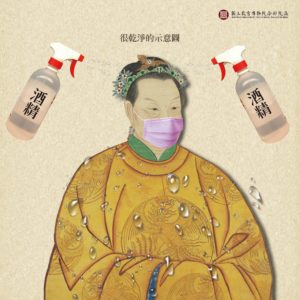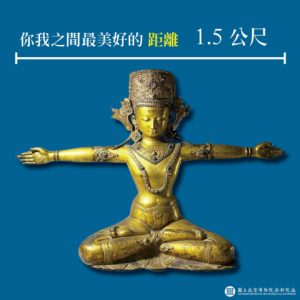by Brian Hioe
語言:
English
Photo Credit: 疾病管制署 – 1922防疫達人/Facebook
WITH MUCH INTERNATIONAL praise of Taiwan’s handling of the COVID-19 pandemic, in avoiding expansive lockdown measures and avoiding domestic transmission of the coronavirus, a major factor in Taiwan’s successes has been the ability of the government and society to communicate information about measures to prevent the spread of the coronavirus. As such, examining the aesthetics of the COVID-19 pandemic in Taiwanese society may be instructive.
Recent images featuring spokesdog Zongchai. Photo credit: 衛生福利部
Firstly, the Taiwanese government’s messaging has aimed to spread information about COVID-19 prevention measures in a cutesy, aestheticized form. This would be for the sake of downplaying any intrusive or disruptive aspects of COVID-19 pandemic prevention measures, in order to try and induce members of the public into complying with them.
For example, as has been widely noted, the Centers for Disease Control has taken to using images of a Shiba Inu mascot, Zongchai, in order to distribute information about the COVID-19 pandemic. While Zongchai has proved highly popular among young people, images of Zongchai have also been deliberately released in the format of “senior images”, in order to allow for information about COVID-19 to be disseminated in a form that the elderly can easily understand. On the whole, images of Zongchai, which depict Zongchai as a mischievous character, actually tend to be rather text-heavy.
Images released by the Southern Branch of the National Palace Museum touching upon the COVID-19 pandemic, the first of which features Minister of Health Chen Shih-chung. Photo credit: 國立故宮博物院南部院區/Facebook
An unusual effect of the COVID-19 pandemic has been the sudden popularity of Minister of Health Chen Shih-chung. Chen has been praised for his work ethic, in working over 25 continuous hours at some points during the pandemic, and his daily press conferences to provide updates about the pandemic.
Consequently, one has also observed cartoon depictions of Chen released by the Taiwanese government. Cartoon images of Chen are released in order to capitalize on Chen’s image. One also observes a number of “fan art” depictions of Chen, in Taiwanese webcomics, advertising images released by the National Palace Museum, latte art, and perhaps most memorably, a cake with Chen Shih-chung’s likeness created by a group of students.
Lectures on epidemiology offered by vice president Chen Chien-jen. Photo credit: 陳建仁/Facebook
Indeed, Taiwanese politicians have taken to using social media to spread awareness of the coronavirus. Vice president Chen Chien-jen, an epidemiologist who coordinated Taiwan’s response to the 2003 SARS epidemic, has notably taken to posting basic lessons in epidemiology on social media. Other posts on social media by Taiwanese politicians during the COVID-19 pandemic touch upon calls for Taiwan to redesign its passport or rebrand national air carrier China Airlines in order to avoid confusion with China. This has led pan-Green politicians such as Minister of Transportation and Communication Lin Chia-lung to post imaginative visions of what a redesigned China Airlines might look like on Instagram.
Humorous image of what a redesigned China Airlines might look like from Minister of Transportation and Communications Lin Chia-lung. Photo credit: 林佳龍/Facebook
It may not be surprising that advertising from Taiwanese companies has also sometimes riffed off of COVID-19, with frequent depictions of corporate mascots wearing medical masks, or inventive products themed around COVID-19. A memorable example would be a toilet paper-themed cake from bakery chain Sunmerry, riffing off of toilet paper shortages caused by panic buying during the pandemic.
 Toilet paper-themed cake from bakery chain Sunmerry. Photo credit: Brian Hioe
Toilet paper-themed cake from bakery chain Sunmerry. Photo credit: Brian Hioe
Some businesses have also taken to commemorating milestones in Taiwan’s efforts to fight COVID-19. The Grand Hotel, for example, will light up its windows to commemorate days in which Taiwan has recorded zero increase in COVID-19 cases, as do other buildings in urban centers.
 The Grand Hotel lit up with “Zero”. Photo credit: 圓山大飯店/Facebook
The Grand Hotel lit up with “Zero”. Photo credit: 圓山大飯店/Facebook
Designer Aaron Nieh’s ad in the New York Times highlighting Taiwan’s contributions to international health has proved a particularly significant event in the aesthetics of the COVID-19 pandemic in Taiwan. The ad in question was crowdfunded by individuals involved in crowdfunding the Democracy at 4 am ad in international newspapers during the Sunflower Movement.
From left to right, the original ad by Aaron Nieh in the New York Times, a variant released by Nieh to commemorate zero new COVID-19 cases in Taiwan, and riffs on the ad by video-conferencing equipment company Ricoh Taiwan, underground techno nightclub B1, and Taiwanese condom brand drippp, the last of which has the memorable tagline, “In a time of isolation, we choose sex”. Photo credit: 聶永真/Facebook, Ricoh Taiwan, B1/Instagram, drippp/Facebook
One has noted a large number of spin-offs of Nieh’s ad to date. Apart from variations by Nieh himself to commemorate events such as zero daily increases in COVID-19 cases, there have been variations on Nieh’s ad from everything from nightclubs to condom companies.
So long as the COVID-19 pandemic continues in Taiwan, one expects continued depictions of it in popular media, government messaging, and advertising. The outcome of the pandemic remains unclear, however, but the communicative strategies adopted by the government and by society are likely to have played a key part in spreading social awareness of the outbreak












